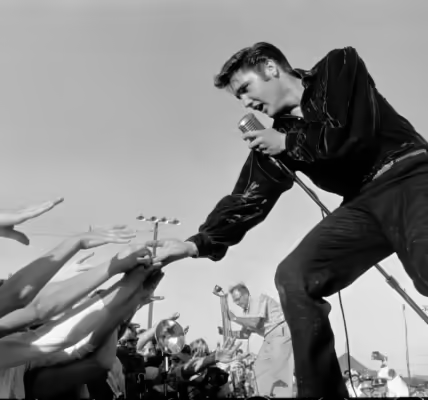- Homepage
- Uncategorized
- “My Desert Serenade” – Elvis Presley’s Enchanting Musical Oasis, is a Captivating Melody that Transports Listeners to a Vast Desert Expanse.0h
“My Desert Serenade” – Elvis Presley’s Enchanting Musical Oasis, is a Captivating Melody that Transports Listeners to a Vast Desert Expanse.0h
“My Desert Serenade” by Elvis Presley is a mesmerizing musical journey that immerses listeners in the vast and tranquil expanse of the desert. Released in 1965, this enchanting tune stands out as a unique gem in Presley’s extensive repertoire, showcasing his versatility as an artist and his ability to evoke vivid imagery through his music.

The song begins with a gentle acoustic guitar riff, reminiscent of the soft whisper of desert winds. As Presley’s velvety vocals come in, accompanied by subtle percussion and lush orchestration, listeners are immediately drawn into the serene beauty of the desert landscape. His voice, rich with emotion and sincerity, carries the listener through the enchanting melody like a seasoned traveler guiding them through uncharted terrain.
“My Desert Serenade” is more than just a song; it’s a musical mirage, capturing the essence of the desert’s mystique. Presley’s delivery is imbued with a sense of longing and reverence, as if he is paying homage to the timeless allure of the desert wilderness. The lyrics, which speak of love and longing amidst the vastness of the desert, resonate with listeners on a deeply emotional level, evoking feelings of introspection and contemplation.
Throughout the song, Presley’s vocal performance is nothing short of captivating. His ability to convey the nuances of emotion through his voice is truly remarkable, drawing listeners in and holding them spellbound until the last note fades away. The arrangement, with its lush instrumentation and haunting melodies, further enhances the ethereal quality of the song, creating a sonic landscape that is both captivating and immersive.
As “My Desert Serenade” comes to a close, listeners are left with a sense of awe and wonder, as if they have just experienced a glimpse of the sublime beauty of the desert at sunset. It’s a testament to Presley’s artistry that a song can transport listeners to such a vivid and evocative place, capturing the essence of a landscape and turning it into a timeless musical masterpiece.
Elvis Aaron Presley, often referred to as the “King of Rock and Roll,” was born on January 8, 1935, in Tupelo, Mississippi, USA. He rose to prominence in the mid-1950s, becoming one of the most iconic and influential figures in the history of popular music. Presley’s musical journey began at an early age when he started singing in church and listening to various genres of music, including gospel, blues, and country. In 1954, he signed a recording contract with Sun Records, where he began his career blending elements of rockabilly, rhythm and blues, and country music. His breakthrough came with the release of his first single, “That’s All Right,” followed by a string of hits such as “Heartbreak Hotel,” “Hound Dog,” and “Jailhouse Rock.” With his charismatic stage presence, distinctive voice, and provocative dance moves, Presley captured the hearts of audiences worldwide, revolutionizing the music industry and popular culture. Presley’s impact extended beyond music; he also found success as an actor, starring in a series of films throughout the 1960s. Despite his commercial success, he faced criticism from some quarters for his crossover into mainstream entertainment and the perceived dilution of his musical authenticity. Throughout his career, Presley struggled with the pressures of fame, leading to personal challenges, including substance abuse and health issues. Despite these obstacles, he remained a beloved figure, revered for his contributions to music and his enduring legacy. Tragically, Elvis Presley passed away on August 16, 1977, at the age of 42, leaving behind a legacy that continues to resonate with generations of fans. He was posthumously inducted into the Rock and Roll Hall of Fame, and his music remains a timeless testament to his enduring talent and cultural impact.

